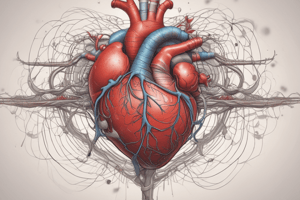Podcast
Questions and Answers
What is the primary function of the heart?
What is the primary function of the heart?
- Circulating blood throughout the body (correct)
- Pumping blood to the lungs
- Producing red blood cells
- Pumping blood to the liver
Which chambers of the heart receive blood during the diastolic phase?
Which chambers of the heart receive blood during the diastolic phase?
- Left and right ventricles
- Left and right atria (correct)
- Pericardium and sac
- Aorta and pulmonary artery
What protects the heart from the surrounding tissues?
What protects the heart from the surrounding tissues?
- Aorta
- Pericardium (correct)
- Mitral valve
- Pulmonary artery
During which phase does the heart contract, forcing blood out of the chambers?
During which phase does the heart contract, forcing blood out of the chambers?
What causes blood to flow into the heart during the diastolic phase?
What causes blood to flow into the heart during the diastolic phase?
What is the main artery of the circulatory system?
What is the main artery of the circulatory system?
Which type of blood is pumped from the body back to the heart through the vena cava?
Which type of blood is pumped from the body back to the heart through the vena cava?
What is the normal resting heart rate for adults?
What is the normal resting heart rate for adults?
Which factor can affect the heart's function in blood circulation?
Which factor can affect the heart's function in blood circulation?
Why is a properly functioning heart essential for maintaining overall health?
Why is a properly functioning heart essential for maintaining overall health?
Flashcards are hidden until you start studying
Study Notes
How the Heart Functions: Understanding Blood Circulation
The heart is a vital organ that plays a crucial role in maintaining our overall health. Its primary function is to circulate blood throughout the body, providing oxygen and nutrients to cells and removing waste products. In this article, we will explore the heart's role in blood circulation and its importance in maintaining our well-being.
The Heart's Anatomy and Structure
The heart is a muscular organ located in the chest, approximately the size of a fist. It is divided into four chambers: the left and right atria (upper chambers) and the left and right ventricles (lower chambers). The heart is also surrounded by a sac called the pericardium, which protects it from the surrounding tissues.
Blood Circulation Process
The heart's function can be divided into two main processes: the diastolic phase and the systolic phase. During the diastolic phase, the heart relaxes and allows blood to flow into the chambers. This process is driven by pressure differences in the blood vessels, causing blood to flow into the heart. The blood that enters the left atrium is then forced into the left ventricle through the mitral valve, and the blood that enters the right atrium is forced into the right ventricle through the tricuspid valve.
During the systolic phase, the heart contracts, forcing the blood out of the chambers and into the aorta. The blood is then pumped out of the heart and into the aorta, which is the main artery of the circulatory system. The blood is then carried to the rest of the body through a network of arteries and capillaries.
Oxygenation and Deoxygenation
Oxygen-rich blood, which is bright red in color, is pumped from the heart to the lungs, where it picks up oxygen from inhaled air. The oxygen-rich blood then returns to the heart and is pumped out to the rest of the body through the aorta. On the other hand, deoxygenated blood, which is dark red in color, is pumped from the body back to the heart through the vena cava and other veins. This deoxygenated blood then passes through the lungs, where it releases carbon dioxide and picks up oxygen to be transported back to the heart.
Blood Pressure and Heart Rate
Blood pressure and heart rate are closely related to the heart's function in blood circulation. Blood pressure is the force exerted by the blood on the walls of the blood vessels and is measured in millimeters of mercury (mmHg). A normal blood pressure reading is 120/80 mmHg. Heart rate, on the other hand, is the number of times the heart beats per minute and is measured in beats per minute (bpm). A normal resting heart rate for adults is between 60 and 100 bpm.
Factors Affecting Heart Function
Several factors can affect the heart's function in blood circulation, including age, genetics, lifestyle, and medical conditions. For example, as we age, the heart may become less efficient at pumping blood, leading to a condition called heart failure. Similarly, certain medical conditions, such as high blood pressure, diabetes, and high cholesterol, can also impact the heart's ability to function properly.
Importance of Heart Function in Blood Circulation
The heart's function in blood circulation is essential for maintaining our overall health. A properly functioning heart ensures that oxygen-rich blood is delivered to all cells in the body and that waste products are removed. If the heart is not able to pump blood effectively, it can lead to a range of health problems, including fatigue, shortness of breath, and even heart failure.
In conclusion, the heart plays a critical role in maintaining our health through its function in blood circulation. By understanding the heart's anatomy, the processes involved in blood circulation, and the factors that can affect its function, we can better appreciate the importance of maintaining a healthy heart.
Studying That Suits You
Use AI to generate personalized quizzes and flashcards to suit your learning preferences.




